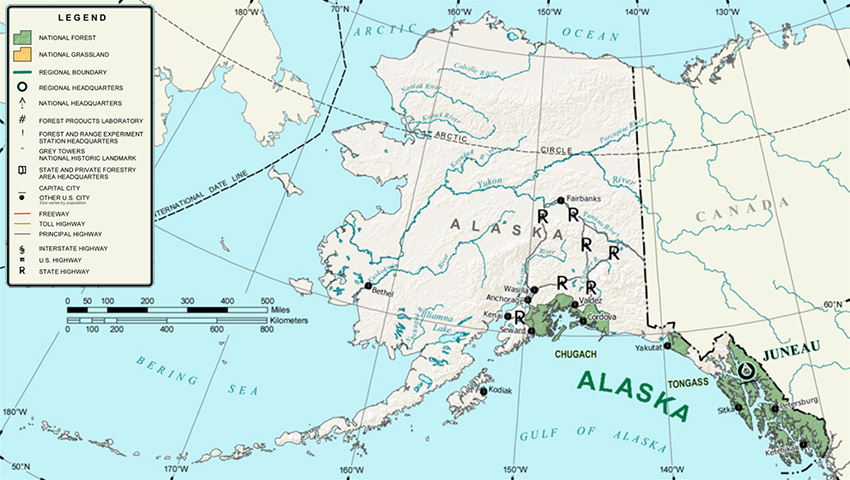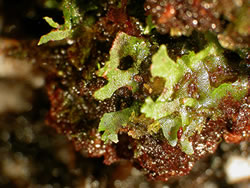Alaska Region
 Alaska Region. From “Guide to Your National Forests and Grasslands (PDF)”, 2006.
Alaska Region. From “Guide to Your National Forests and Grasslands (PDF)”, 2006.
The Alaska Region occupies the rugged, mountainous coast of the northeast Pacific Ocean. The maze of fjords and islands, streams and mountains characterizing the Region support a wide array of vegetation types ranging from vast wetlands to luxuriant temperate rainforests to magnificent alpine ecosystems.
There are only two national forests in the Alaska Region, the Tongass National Forest and the Chugach National Forest; however, they are the largest national forests in the Country. The Chugach surrounds Prince William Sound and is near Anchorage, Alaska's largest city. The Tongass National Forest includes the islands and mainland of southeastern Alaska and surrounds the towns of Ketchikan, Sitka, Juneau, Petersburg, Wrangell, Yakutat and Skagway.
Many of the plants in the Alaska Region produce spectacular wildflowers and colorful foliage, providing excellent opportunities to enjoy native plants from spring through autumn.
News
The Big Search for Tiny Ferns
Posted April 22, 2015
 Hymenophyllum wrightii gametophytes growing in a tangled clump on rotting wood. Photo by Aaron Duffy.
Hymenophyllum wrightii gametophytes growing in a tangled clump on rotting wood. Photo by Aaron Duffy.
For many years, Forest Service botanists have been interested in finding an elusive plant called Wright’s filmy fern (Hymenophyllum wrightii) in the Alaska Region. The fern was designated by the Regional Forester as an Alaska Region Sensitive Species in 1994 because of its apparent rarity. However, interest in the plant began several decades earlier.
Read more about the big search for tiny ferns on the USDA Blog…
Botany Challenge 49
Posted June 18, 2013
The Falls Creek area of the Chugach State Park, Alaska, is immensely beautiful and includes verdant forests, species rich shrublands, and a lively stream. The trailhead is about 20 miles east of Anchorage on the Seward Highway. On the evening of June 13, 2013, “Botany Challenge 49” was held. The hiking group sought to identify 49 species of native plants (Alaska being the 49th state) and to note the phenological state of each (vegetative, flowering, fruiting). There were eleven participants (9 people and 2 dogs) in the botany challenge event, which extended from sea level to about 1,200 feet elevation along the Falls Creek Trail in Chugach State Park.
Read more about Botany Challenge 49…
Rare Plant Conservation Success Stories
- Aleutian Cress Relocated on the Chugach National Forest, Alaska
- Henderson's Checkerbloom (Sidalcea hendersonii) Newly Discovered in Alaska
Regional Information
Mushrooms of the National Forests in Alaska (PDF, 2.9 MB)
The coastal temperate rainforests of the Tongass and Chugach national forests often produce prolific fruitings of mushrooms in late summer and fall. For many Alaskans, mushrooms are a source of food. For others, they are a source of pigments for dyeing wool and other natural fibers. Still others merely enjoy their beauty. However, all Alaskans should appreciate these fungi for, without them, there would be no forests here.
This brochure was prepared by the Forest Service, Alaska Region Botany Program with funding from the Forest Management Program (Special Forest Products). Text by Kate Mohatt (Chugach National Forest ecologist), Karen Dillman (Tongass National Forest ecologist) and Dr. Steven Trudell. Illustrations by Marsha Mello and photographs by Steven Trudell except where noted otherwise.
Also see the Spanish translation: Hongos de los Bosques Nacionales de Alaska (PDF, 3.6 MB).
Wildflowers of the National Forests in Alaska (PDF, 1.1 MB)
Wildflowers of the National Forests in Alaska highlights 50 of the most common wildflowers found in Alaska's two National Forests, the Tongass National Forest and the Chugach National Forest.
Photographs provided by Mary Stensvold, Rick Turner, Brad Krieckhaus, Karen Dillman, Ellen Anderson, Ernest Manewal, Jay VerHoef and the USDA Forest Service Alaska Region collection.
Ferns of the National Forests in Alaska (PDF, 4.2 MB)
Ferns abound in Alaska's two national forests, the Chugach and the Tongass, which are situated on the southcentral and southeastern coast respectively. These forests contain myriad habitats where ferns thrive. Most showy are the ferns occupying the forest floor of temperate rainforest habitats. However, ferns grow in nearly all non-forested habitats such as beach meadows, wet meadows, alpine meadows, high alpine, and talus slopes. The cool, wet climate highly influenced by the Pacific Ocean creates ideal growing conditions for ferns.
This brochure was prepared by the Forest Service, Alaska Region Botany program. Text, diagrams and photographs by Mary Stensvold unless otherwise noted.
Lichens of Alaska's South Coast (PDF, 1.8 MB)
This brochure highlights 31 of the more than 1,000 lichens found across the south coast of Alaska (from Kodiak Island to Ketchikan). This region includes the Tongass and Chugach national forests, the Glacier Bay, Lake Clark, Katmai, and Wrangell-St. Elias national parks and preserves, the Klondike Gold Rush and Sitka national historical parks, Kenai Fjords National Park, and the US Fish and Wildlife Service Kodiak, Kenai, and Maritime national wildlife refuges.
This brochure was prepared by the botany program of the Forest Service, Alaska Region. Photographs are by Karen L. Dillman unless otherwise noted. Drawings are by Alexander Mikulin.
Also See…
Wildflower Photographs

White marsh marigold (Caltha leptosepala). Kenai Peninsula, Chugach National Forest. Photo by Mary Stensvold.

Nootka Lupine (Lupinus nootaktensis). Yakutat, Tongass National Forest. Photo by Mary Stensvold.

Forget me not (Myosotis alpestris). Alaska State Flower. Chugach National Forest. Photo by Mary Stensvold.

Devil’s club (Oplopanax horridus). Prince of Whales Island, Tongass National Forest. Photo by Mary Stensvold.

Cooley’s buttercup (Ranunculus cooleyae). Juneau alpine, Tongass National Forest. Photo by Mary Stensvold.

Salmonberry (Rubus spectabilis). Sitka, Tongass National Forest. Photo by Mary Stensvold.







